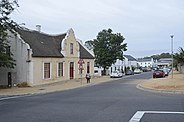This article needs additional citations for verification. (February 2013) |
Malmesbury | |
|---|---|
Top, The Malmesbury skyline at dusk. Middle left, a view down Loedolff Street. Middle right, the Dutch Reformed Church in Malmesbury. Lower left, the Malmesbury Museum. Lower right, the Baron Von Elgg Victorian era home built in 1890, the town has a number of similar surviving Victorian era homes. | |
| Coordinates: 33°27′S 18°44′E / 33.450°S 18.733°E | |
| Country | South Africa |
| Province | Western Cape |
| District | West Coast |
| Municipality | Swartland |
| Established | 1745[1] |
| Area | |
| • Total | 18.8 km2 (7.3 sq mi) |
| Population (2011)[2] | |
| • Total | 35,897 |
| • Density | 1,900/km2 (4,900/sq mi) |
| Racial makeup (2011) | |
| • Black African | 24.9% |
| • Coloured | 55.3% |
| • Indian/Asian | 0.5% |
| • White | 18.4% |
| • Other | 0.9% |
| First languages (2011) | |
| • Afrikaans | 73.9% |
| • Xhosa | 16.3% |
| • English | 3.8% |
| • Sotho | 3.1% |
| • Other | 2.8% |
| Time zone | UTC+2 (SAST) |
| Postal code (street) | 7300 |
| PO box | 7299 |
| Area code | 022 |
Malmesbury is a town of approximately 36,000 inhabitants in the Western Cape province of South Africa, about 65 km north of Cape Town.
The town is the largest in the Swartland (‘black land’) which took its name from the renosterbos ('rhino bush'), an indigenous plant that turns black in the warm, dry summers. The area is especially known for its grain and wine cultivation as well as sheep and poultry farming.
Malmesbury was named after Sir Lowry Cole's father-in-law, the Earl of Malmesbury. Settlers were encouraged to make their homes here because of a tepid sulphur chloride mineral spring that was renowned for curing rheumatism. The first farms were allocated in 1703. When the fifth Dutch Reformed congregation in the Cape was established here, it became known as Zwartlands-kerk (Swartland Church) but was renamed Malmesbury in 1829. The town acquired municipal status in 1860.
The town no longer attracts the ailing because this aspect was never developed by the local authority, and today a shopping centre is located on top of the site with only a decorative fountain marking the location of the original spring.
- ^ Robson, Linda Gillian (2011). "Annexure A" (PDF). The Royal Engineers and settlement planning in the Cape Colony 1806–1872: Approach, methodology and impact (PhD thesis). University of Pretoria. pp. xlv–lii. hdl:2263/26503.
- ^ a b c d Sum of the following Main Places from Census 2011: Mount Royal Golf & Country Estate, Wesbank, Malmesbury, Ilinge Lethu.







